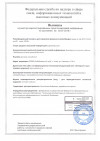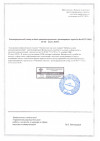Резюме
| Название статьи | АНАЛИЗ СТРУКТУРЫ ОСЛОЖНЕНИЙ НОВОЙ КОРОНАВИРУСНОЙ ИНФЕКЦИИ У УМЕРШИХ ПАЦИЕНТОВ |
|---|---|
| Title | ANALYSIS OF THE STRUCTURE OF COMPLICATIONS OF A NEW CORONAVIRUS INFECTION IN PATIENTS WHO HAVE DIED |
| Категория | номер 2 за 2023 год (опубликован 10.07.2023) |
| Тип | Научная статья |
| Ключевые слова | новая коронавирусная инфекция, COVID-19, осложнения |
| Keywords | novel coronavirus infection, COVID-19, complications |
| Скачать | Скачать статью |
| doi | 10.52485/19986173_2023_2_39 |
| УДК | 616-06-053.18-02:616.98:578.834.1 |
| Резюме | Цель исследования. Изучить частоту и виды осложнений у пациентов, умерших от новой коронавирусной инфекции (COVID-19). Материалы и методы. Проведено ретроспективное исследование медицинских карт стационарных больных и экспертиз качества медицинской помощи 61 пациента с тяжелым и крайне-тяжелым течением COVID-19, умерших в больницах Иркутской области в период с 1 января 2021 по 31 декабря 2021. В исследование включены пациенты в возрасте старше 18 лет с положительным результатом лабораторного исследования на наличие РНК SARS-CoV-2. Исключены из исследования пациенты с невыполнением, несвоевременным или ненадлежащим выполнением необходимых пациенту диагностических мероприятий; с невыполнением обязательного патологоанатомического вскрытия; с наличием признаков искажения сведений о проведенных диагностических и лечебных мероприятиях. Результаты. Установлено, что наиболее частым осложнением у умерших пациентов от новой коронавирусной инфекции (COVID-19), была пневмония, затем следовали отек головного мозга, сепсис, госпитальное острое почечное повреждение, метаболический ацидоз, острое повреждение миокарда, респираторный ацидоз, аритмии, перегрузка жидкостью, острое нарушение мозгового кровообращения, тромбэмболия легочной артерии, острая сердечная недостаточность, реже регистрировались диссеминированное внутрисосудистое свертывание крови и делирий. Причинами метаболического ацидоза в большинстве случаев были сепсис и острое почечное повреждение, а респираторного ацидоза – острый респираторный дистресс-синдром. Заключение. Новая коронавирусная инфекция (COVID-19) вызывает повреждения легких, головного мозга, сердца и почек, которые обуславливают тяжесть состояния пациентов и приводят к летальным исходам. |
| Список литературы | 1. Poorolajal J. The global pandemics are getting more frequent and severe. J of Research in Health Sciences. 2021. 21(1). e00502. doi:10.34172/jrhs.2021.40. - PMID 34024760. |
| 2. COVID-19 Dashboard by the Center for Systems Science and Engineering (CSSE) at Johns Hopkins University (JHU). ArcGIS. Johns Hopkins University. Дата обращения: 31 января 2023. | |
| 3. Zhou F., Yu T., Du R. et al. Clinical course and risk factors for mortality of adult inpatients with COVID-19 in Wuhan, China: a retrospective cohort study. Lancet. 2020. S0140-6736(20)30566-3. doi:10.1016/S0140-6736(20)30566-3. | |
| 4. Ruan Q., Yang K., Wang W., Jiang L., Song J. Clinical predictors of mortality due to COVID-19 based on an analysis of data of 150 patients from Wuhan, China. Intensive Care Med. 2020. doi:10.1007/s00134-020-05991-x | |
| 5. Shi S., Qin M., Shen B. et al. Association of Cardiac Injury With Mortality in Hospitalized Patients With COVID-19 in Wuhan, China. JAMA Cardiol. 2020. 5 (7). 802-810. doi:10.1001/jamacardio.2020.0950. | |
| 6. Pellicori P., Doolub G., Wong C.M. et al. COVID-19 and its cardiovascular effects: a systematic review of prevalence studies. Cochrane Database Syst. Rev. 2021. 3 (3). CD013879. doi: 10.1002/14651858. CD013879.PMID: 33704775 | |
| 7. Pathophysiology of Cardiovascular Complications in COVID-19 https://www.frontiersin.org/ articles/10.3389/fphys.2020.575600/full. | |
| 8. Madjid M., Safavi-Naeini P., Solomon S.D., Vardeny О. Potential effects of coronaviruses on the cardiovascular system: a review. JAMA Cardiol. 2020. 5(7). 831-40. | |
| 9. Liu P.P., Blet A., Smyth D., Li H. The science underlying COVID-19: implications for the cardiovascular system. Circulation. 2020. 142(1). 68-78. | |
| 10. Raina R., Mahajan Z.A., Vasistha P. et al. Incidence and outcomes of acute kidney injury in COVID-19: a systematic review. Blood Purif. 2021. 15. 1-14. | |
| 11. Acute respiratory distress syndrome: The Berlin definition. JAMA – J Am Med Assoc. 2012. 307 (23). 2526-2533. | |
| 12. Временные методические рекомендации Минздрава России «Профилактика, диагностика и лечение новой коронавирусной инфекции (COVID-19)» Версия 10 (08.02.2021). https://3quality.ru/blog/medical_workers/interim_guidelines_v10/. | |
| 13. Временные методические рекомендации Минздрава России «Профилактика, диагностика и лечение новой коронавирусной инфекции (COVID-19)» Версия 11 (07.05.2021). https://minzdrav.gov.ru/news/2021/05/07/16568-minzdrav-rossii-vypustil-novuyu-versiyu-metodrekomendatsiy-po-koronavirusu. | |
| 14. Singer M., Deutschman C.S., Seymour C.W. et al. The Third International Consensus Definitions for Sepsis and Septic Shock (Sepsis-3). JAMA. 2016. 315(8). 801-10. | |
| 15. Kidney Disease: Improving Global Outcomes (KDIGO) Acute Kidney Injury Work Group. KDIGO Clinical Practice Guideline for Acute Kidney Injury. Kidney Int. Suppl. 2012. 2 (1). 1-138. DOI: 10.1038/kisup.2011.37. | |
| 16. COVID-19 rapid guideline: Managing COVID-19, v28.0 published on 29/03/2023 https://app.magicapp.org/#/guideline/6897. | |
| 17. Executive summary of the guidelines on the diagnosis and treatment of acute heart failure: The Task Force on Acute Heart Failure of the European Society of Cardiology, European Heart J. 2005. 26(4). 384-416, https://doi.org/10.1093/eurheartj/ehi044. | |
| 18. Scientific Subcommittee on Disseminated Intravascular Coagulation (DIC) of the International Society on Thrombosis and Haemostasis (ISTH). Towards definition, clinical and laboratory criteria, and a scoring system for disseminated intravascular coagulation. Thromb Haemost. 2001. 86. 1327-30. | |
| 19. Deng Y., Liu W., Liu K. et al. Clinical characteristics of fatal and recovered cases of coronavirus disease 2019 in Wuhan, China: a retrospective study. Chin Med J 2020. 133. 1261–1267. doi: 10.1097/CM9.0000000000000824 | |
| 20. Chen T., Wu D., Chen H. et al. Clinical characteristics of 113 deceased patients with coronavirus disease 2019: retrospective study. BMJ 2020. 368. m1091. doi: https://doi.org/10.1136/ bmj.m1091. | |
| Resume | The aim of the research: To study the frequency and types of complications in patients who have died from the novel coronavirus infection (COVID-19). Materials and methods. A retrospective study of medical records of inpatients and examinations of the quality of medical care of 61 patients with severe and extremely severe COVID-19 who died in hospitals of the Irkutsk region in the period from January 1, 2021 to December 31, 2021 was conducted. The study included patients over the age of 18 years with a positive laboratory result for the presence of SARS-CoV-2 RNA. Patients with non-fulfillment, untimely or improper implementation of the diagnostic measures necessary for the patient are excluded from the study; failure to perform a mandatory post-mortem examination; with the presence of signs of distortion of information about the diagnostic and therapeutic measures taken. The results. Pneumonia complicated by acute respiratory distress syndrome was the most common complication, in deceased patients from the novel coronavirus infection COVID-19 followed by cerebral edema, sepsis, hospital acute kidney injury, metabolic acidosis, acute myocardial damage, respiratory acidosis, arrhythmias, fluid overload, аcute cerebrovascular accident, pulmonary thromboembolism, acute heart failure, less often disseminated intravascular coagulation and delirium were recorded. The causes of metabolic acidosis in most cases were sepsis and acute kidney injury, and respiratory acidosis - acute respiratory distress syndrome. Conclusion. The novel coronavirus infection COVID-19 causes damage to the lungs, brain, heart and kidneys, which causes the severity of the patient's condition and leads to death. |
| Автор 1 | Дац Андрей Владимирович |
| Автор 2 | Дац Людмила Сергеевна |



